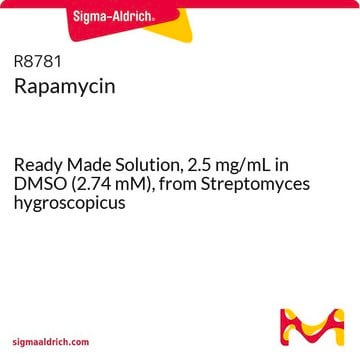553211
Rapamycin
≥95% (HPLC), solution, mTOR inhibitor, Calbiochem
Sinônimo(s):
InSolution Rapamycin, mTOR Inhibitor I
About This Item
Produtos recomendados
product name
Rapamycin, InSolution, ≥98%, 5 mM, inhibits mTOR and blocks activation of p70 S6 Kinase
Nível de qualidade
Ensaio
≥95% (HPLC)
forma
solution
fabricante/nome comercial
Calbiochem®
condição de armazenamento
desiccated (hygroscopic)
protect from light
Condições de expedição
wet ice
temperatura de armazenamento
−20°C
Descrição geral
Ações bioquímicas/fisiológicas
Mammalian target of rapamycin (mTOR)
Embalagem
Advertência
forma física
Reconstituição
Informações legais
Código de classe de armazenamento
10 - Combustible liquids
Classe de risco de água (WGK)
WGK 1
Ponto de fulgor (°F)
188.6 °F - closed cup - (Dimethylsulfoxide)
Ponto de fulgor (°C)
87 °C - closed cup - (Dimethylsulfoxide)
Certificados de análise (COA)
Busque Certificados de análise (COA) digitando o Número do Lote do produto. Os números de lote e remessa podem ser encontrados no rótulo de um produto após a palavra “Lot” ou “Batch”.
Já possui este produto?
Encontre a documentação dos produtos que você adquiriu recentemente na biblioteca de documentos.
Os clientes também visualizaram
Nossa equipe de cientistas tem experiência em todas as áreas de pesquisa, incluindo Life Sciences, ciência de materiais, síntese química, cromatografia, química analítica e muitas outras.
Entre em contato com a assistência técnica






